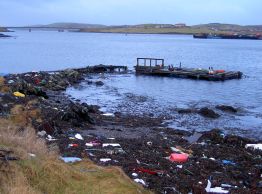Project Aim
The aim of "Save the North Sea" is to contribute to a sustainable and less polluted North Sea by influencing attitudes and behaviour regarding marine litter among groups who are among the key sources of this problem: the fishing, offshore, recreational and shipping industries. Save the North Sea is supported by the Swedish, Danish and Scottish Ministries of the Environment as well as the Dutch Ministry of Transport, Public Works and Water Management.
Project implementation and results
Within the North Sea region, over 20000 tons of marine litter are dumped every year, resulting in economic, social and environmental impacts. Beaches important for tourism are blighted with litter, while local authorities spend over 4.2 million each year cleaning them up. Marine litter can also harm wildlife through entanglement, ingestion, smothering or toxicity.
Activities
Against this background, the project focused on cross-sectoral activities to minimize marine litter pollution with a pilot study on better waste management systems; market research studies to provide new information sources on the underlying causes to why marine litter continues to exist despite EU directives; and research on Fulmars to give marine litter indicators. The project also aimed to create new cooperation structures and knowledge platforms for national, regional and local authorities as well as policy makers, opinion builders, SMEs and NGOs in the region.
The project team of Save the North Sea was very successful in attracting a dedicated audience to the project activities. Politicians, international organisations, schools, fishermen and the public in general were not only being made aware about the project but more importantly about the common resource that we all share, i.e. the North Sea, and the threats from uncontrolled day-to-day practices, e.g. pollution of the water body and coast, as well as threats to living species.
Filming on Texel with Dutch national school TV for a programme on marine litter, Fishing for litter and the SNS Fulmar research was carried out and aired nationally in February 2003. The SNS promotional film was distributed to over 500 local and national politicians, MEPs, NGOs, TV stations, and North Sea stakeholders in the whole North Sea region. Project activities included the launch of the Fishing for Litter campaign in Scotland and Sweden, a presentation of SNS at a Coastal Litter Conference in Edinburgh, Scotland and the production and distribution of an A4 information leaflet on SNS activities for stakeholders. A team from the British trust for Ornithology visited Alterra to dissect Fulmars. After training they will now be able to deliver dissection data and stomachs to Alterra for use in SNS research.
Joint transnational strategy
This project is a prime example of successful transnational and cross-sectoral working. One example of added value from the project is the fact that each partner has become educated in each of the separate strands of the project. They have gained new skills and knowledge, which has consequently enabled them to speak with ease to journalists generically about the project and not just about the parts that they are involved in. This has been particularly beneficial as the project has attracted significant media attention.
Mode of cooperation
The project could not have achieved the desired outputs and results without working transnationally, across target groups, countries and specific sectors to achieve a reduction in marine litter. This cross-sectoral approach involving fishermen, seamen, offshore and leisure craft sectors in a positive campaign, and a focus on joint responsibility for the state of the North Sea was the best way to encourage stakeholders. The project gave stakeholders an active role to play in the international stakeholder reference group with bi-annual meetings, and practical work to do within the project (information dissemination on all levels).
Impact of the project
Long-term achievements and policy shaping
The project received a UN-Habitat Programme ‘Good Practice’ award for being one of the most sustainable projects in the world. Politically the project has also received recognition at CONSSO, OSPAR and Environmental Minister Meetings. As a result of the recycling machine that was installed as part of the project, four unemployed people obtained work. Now that the project has been completed three of these people have obtained full-time work at the harbour in Skagen, DK.
Finally, the project has reached all its objectives and aims, and has had an enormous PR- and dissemination coverage. |

Marine litter in the North Sea
Partners Skagen Uddannelsescenter, DK
Swedish Environmental Protection Agency, SE
KIMO International, UK
Foundation for Environmental Education (FEE), NO
Wageningen Marien (Formerly Alterra - Texel Marine & Coastal Zone), NL
Keep Scotland Beautiful, UK
LP:
Keep Sweden Tidy Foundation
Project Manager
Contact:
Elin Svensson and Hanna Hedinius
Keep Sweden Tidy Foundation
Box 5243 S-402 24 Gothenburg
Sweden
elin.svensson@hsr.se; hanna.hedenius@hsr.se
www.savethenorthsea.com
Tel: +46 8 505 263 59
Measure: 3.3
Start Date: 27 February 2002
End Date: 31 December 2004
ERDF Grant:
 2.849.000,00 2.849.000,00
Total Eligible Sum:
 5.698.000,00 5.698.000,00
|